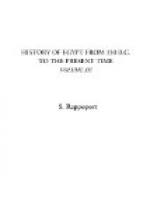The work of Young and Champollion, says Doctor Williams,* gives a new interest to the mass of records, in the form of graven inscriptions, and papyrus rolls, and cases and wrappings, which abound in Egypt, but which hitherto had served no better purpose for centuries than to excite, without satisfying, the curiosity of the traveller.
* History of the Art of Writing, Portfolio I., plate 8.
Now these strange records, so long enigmatic, could be read, and within the past fifty years a vast literature of translations of these Egyptian records has been given to the world. It was early discovered that the hieroglyphic character was not reserved solely for sacred inscriptions, as the Greeks had supposed in naming it; indeed, the inscription of the Rosetta Stone sufficiently dispelled that illusion. But no one, perhaps, was prepared for the revelations that were soon made as to the extent of range of these various inscriptions, and the strictly literary character of some of them.
A large proportion of these inscriptions are, to be sure, religious in character, but there are other extensive inscriptions, such as those on the walls of the temple of Karnak, that are strictly historical; telling of the warlike deeds of such mighty kings as Thutmosis III. and Ramses II. Again, there are documents which belong to the domain of belles-lettres pure and simple. Of these the best known example is the now famous “Tale of Two Brothers”—the prototype of the “modern” short story.
Up to the middle of the nineteenth century, no Egyptologist had discovered that the grave-faced personages who lie in their mummy-cases in our great museums ever read or composed romance. Their literature, as far as recovered, was of an eminently serious nature,—hymns to the divinities, epic poems, writings on magic and science, business letters, etc., but no stories. In 1852, however, an Englishwoman, Mrs. Elizabeth d’Orbiney, sent M. de Rouge, at Paris, a papyrus she had purchased in Italy, and whose contents she was anxious to know. Thus was the tale of the “Two Brothers” brought to light, and for twelve years it remained our sole specimen of a species of literature which is now constantly being added to.
This remarkable papyrus dates from the thirteenth century B.C., and was the work of Anna, one of the most distinguished temple-scribes of his age. Indeed, it is to him that we are indebted for a large portion of the Egyptian literature that has been preserved to us. This particular work was executed for Seti II., son of Meneptah, and grandson of Ramses II. of the nineteenth dynasty, while he was yet crown prince.
The tale itself is clearly formed of two parts. The first, up to the Bata’s self-exile to the Valley of the Cedar, gives a really excellent picture of the life and habits of the peasant dwelling on the banks of the Nile. The civilisation and moral conditions it describes are distinctly Egyptian. Were it not for such details as the words spoken by the cows, and the miraculous appearance of the body of water between the two brothers, we might say the ancient Egyptians were strict realists in their theory of fiction. But the second part leads us through marvels enough to satisfy the most vivid of imaginations. It is possible, therefore, that the tale as we have it was originally two separate stories.




